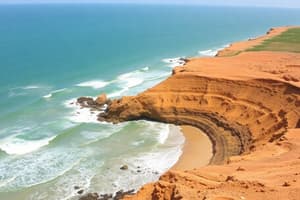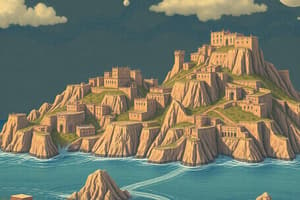Podcast
Questions and Answers
How does an erosional coast differ from a depositional coast?
How does an erosional coast differ from a depositional coast?
Erosional coasts are new coasts characterized by the removal of coastal material, while depositional coasts are usually older and can grow due to sediment accumulation.
What features would you expect to see along an erosional coast? A depositional coast? What determines how long the features will last?
What features would you expect to see along an erosional coast? A depositional coast? What determines how long the features will last?
Erosional coast features include headlands, rocky shores, and sea stacks. Depositional coast features include beaches, tidal flats, and barrier islands. The duration of these features is determined by the amount of energy in the water.
What two processes contribute to longshore drift? What powers longshore drift? What is the predominant direction of drift on U.S. coasts? Why?
What two processes contribute to longshore drift? What powers longshore drift? What is the predominant direction of drift on U.S. coasts? Why?
The two processes are the continuous swash and backwash of waves, and the prevailing wind direction. Longshore drift is primarily powered by wave action. The predominant direction of drift on U.S. coasts is typically determined by prevailing wind direction.
What are some features of a sandy beach? Are they temporary or permanent? What is the relationship between wave energy on a coast and the size or grain size of beaches?
What are some features of a sandy beach? Are they temporary or permanent? What is the relationship between wave energy on a coast and the size or grain size of beaches?
How are deltas classified? Why are there deltas at the mouths of the Mississippi and Nile rivers but not at the mouth of the Columbia River?
How are deltas classified? Why are there deltas at the mouths of the Mississippi and Nile rivers but not at the mouth of the Columbia River?
What is a coastal cell? Where does sand in a coastal cell come from? Where does it go?
What is a coastal cell? Where does sand in a coastal cell come from? Where does it go?
How are estuaries classified? Upon what does the classification depend? Why are estuaries important?
How are estuaries classified? Upon what does the classification depend? Why are estuaries important?
Compare and contrast the U.S. Atlantic and Pacific coasts.
Compare and contrast the U.S. Atlantic and Pacific coasts.
How do human activities interfere with coastal processes? What steps can be taken to minimize loss of life and property along U.S. coasts?
How do human activities interfere with coastal processes? What steps can be taken to minimize loss of life and property along U.S. coasts?
Flashcards are hidden until you start studying
Study Notes
Erosional vs. Depositional Coasts
- Erosional coasts are characterized by the removal of coastal material, while depositional coasts accumulate sediment, often appearing older and more stable.
Features of Erosional and Depositional Coasts
- Erosional coasts typically have headlands, rocky shores, and sea stacks.
- Depositional coasts feature beaches, tidal flats, and barrier islands.
- The longevity of these features is influenced by water energy levels.
Longshore Drift
- Longshore drift results from wave swash and backwash, combined with prevailing wind directions, causing lateral sand movement.
- Groynes are constructed to limit sideways sand shifts, addressing potential erosion and contributing to spit and tombolo formation when unmanaged.
Sandy Beaches
- Sandy beaches consist of loose particles covering shorelines and are generally permanent features.
- Their formation is caused by wave action transporting sediment to deposition sites.
Deltas
- Deltas are classified based on their formation processes; prominent examples include those at the mouths of the Mississippi and Nile rivers.
- The Columbia River, lacking a delta, loses sediment due to flow characteristics at a sharp bend, which slows water velocity.
Coastal Cells
- A coastal cell is a self-contained geographical unit of coastline where sediment moves.
- River systems primarily supply new sand to coastal cells, which is then relocated by longshore drift and seasonal wave action.
Estuary Classification
- Estuaries are categorized by their shape, river flow volume, and tidal range, influencing their circulation patterns.
- Historically significant for human civilization, estuaries are vital ecosystems.
Comparison of U.S. Atlantic and Pacific Coasts
- The Atlantic Ocean is notable for its green color, stronger currents, greater depth, significant historical trade routes, and features like the Bermuda Triangle.
- The Pacific Ocean appears blue, has less sea traffic, is larger in size, and hosts more volcanic islands along with more frequent underwater eruptions versus the Atlantic.
Human Impact on Coastal Processes
- Human activities like constructing breakwaters disrupt natural wave action, while building on dunes exacerbates coastal erosion.
- To mitigate risks along U.S. coasts, strategies such as installing groins can help manage sediment transport effectively.
Studying That Suits You
Use AI to generate personalized quizzes and flashcards to suit your learning preferences.




